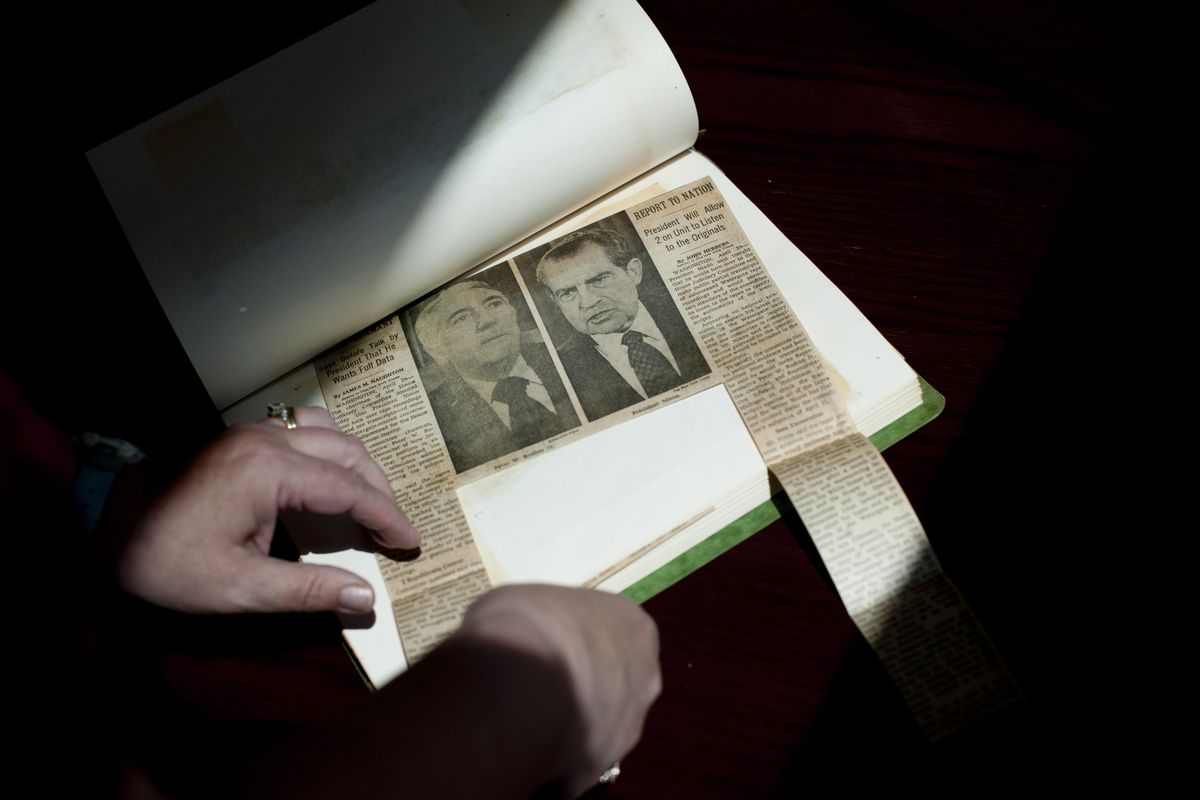Massive collection of Watergate clippings on display
Man’s massive collection of news clippings now available to public

Forty-one years ago this week, a story in the New York Times caught the eye of Drake University student J. Paul Blake: A break-in had occurred at the Democratic National Committee headquarters in Washington, D.C., and investigators and journalists alike suspected the burglars had ties to the Richard Nixon administration.
His curiosity piqued, Blake repeated a ritual begun in his teenage years: He clipped the story from the paper and folded it into a brown envelope.
“That’s the one I saw and put away, and it just looked like it might be something interesting,” Blake said.
The story became the first in a collection that now fills 84 notebooks in the vault of the William Hutchinson Cowles III Rare Book Library at Gonzaga University.
Monday marked the 41st anniversary of the Watergate break-in, and now the public can flip through Blake’s collection and relive the first draft of a scandal that felled a president and launched the careers of at least two fledgling journalists.
Stephanie Plowman, special collections librarian at Gonzaga, said efforts have been slow and steady behind the scenes to make the clippings available to the public and faculty alike. The herculean task has been to replace the yellowed, musty-smelling newsprint Blake originally hoarded with reader-friendly photocopies.
“Students have been working behind the scenes,” she said. “We want to get it out there so people can use it.”
Clippings are not limited to the work of Washington Post reporters Bob Woodward and Carl Bernstein, whose investigative reporting was aided by anonymous source Deep Throat, aka FBI Associate Director Mark Felt, and earned the paper a Pulitzer Prize in 1973. Blake collected stories from papers across the country, digging through trash cans on the Drake campus for wire reports and editorials from hometown papers discarded by fellow students.
“I’d go grab them, and if there was something I didn’t have I would save them as well,” Blake said of the newsprint he unearthed.
The result is a collection that largely mirrors Blake’s own journey. Stories from the early 1970s come from the Des Moines (Iowa) Register while Blake completed a degree in journalism at Drake. He then moved to Minnesota, and articles detailing the fallout of the scandal are neatly clipped from the St. Paul Pioneer Press and Minneapolis Star and Tribune. Blake’s arsenal included an Exacto knife and a jar of rubber cement.
As the years wore on, retrospectives and announcements of Nixon’s death and Felt’s identity are taken from the Seattle Times. Blake served as an assistant vice president at Seattle University and communications director for the city’s public utilities department during the 1980s and ’90s.
Blake bequeathed his collection to Gonzaga after Drake and the University of Washington balked at his offer. He contacted some friends in Spokane who were interested in cataloging the articles. Plowman said the gift comprises the most extensive newspaper collection in the library.
“For students of political science or public history, it’s a great primary source,” Plowman said.
In the clippings, reporters and witnesses to history grapple with the unfolding drama and how to portray Nixon. Cartoonists pull no punches, depicting “Tricky Dick” wrapped in tangles of audio tape. But Franklin B. Smith of the Burlington (Vt.) Free Press blamed the press for going too far in toppling the exalted position of the American presidency, condemning “news leaks, speculations and analyses” as “masquerades that are demonstrably lethal.”
Blake shares their uncertainty after all these years. He praised Nixon for his work opening up China to Western influence, but his moral failings did him in, Blake said.
“In the long run, I almost feel sorry for the guy,” Blake said. “He did some other great things, but his whole legacy is just ruined by Watergate.”